Historical Snapshots 1900 - 1930s
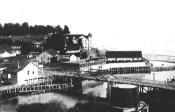
Capitola, ca. 1903
Capitola's grand 160-room hotel was the centerpiece of Capitola from 1895 until it burned in 1929.
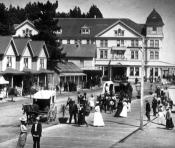
The Esplanade, ca. 1910
A close-up view of the Capitola Hotel, the hotel annex, and the Six Sisters, taken as a promotional photograph about 1910. There are no lawns in front of the Six Sisters, and the street with its trolley line ran right past their front doors. The lawn area was created in 1925, when the Esplanade was curved out onto the beach. The tracks for the trolley were then shifted to Capitola Avenue, but removed when the line went bankrupt a few years later.
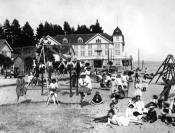
Beach at Capitola, ca. 1915
A number of different swings, slides and other playground equipment for children was the main attraction on Capitola's beach from 1900 through the 1950s. This photograph of the Esplanade was taken about 1915.
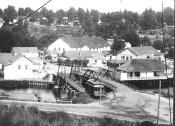
Union Traction Company Trolley Line, ca. 1916
The Union Traction trolley car line, around 1916. The line ran from the Santa Cruz Boardwalk to Capitola from 1904 to 1927. This photograph also shows one of several saloons in Capitola, far left, as well as the skating rink, theater and the concessions along the Esplanade (then called Ocean Front Avenue).
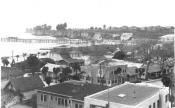
Capitola-by-the-Sea, ca. 1925
The decade of the1920s was H. Allen Rispin's era as the owner and developer of the Capitola seaside resort. During Prohibition, the Hawaiian Gardens Nightclub flourished as one of the hottest entertainment spots in Santa Cruz County. Older cottages in the village were torn down or moved to make way for new stuccoes. The Venetian Courts apartments replaced the old Italian fishing community at the base of the wharf.
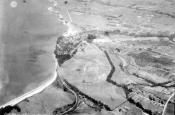
Aerial View of Soquel and Capitola, ca. 1926
Before Highway 1 was completed in 1948, there was no separation between the communities of Soquel and Capitola. This photograph was taken May 12, 1926, a few years before the establishment of the Santa Cruz-Capitola Airport in 1934. The large field in the center of the picture was the site of both the airfield and the 250th Coast Artillery's summer encampment known as Camp McQuaide. Artillery practice continued at Capitola for ten years from 1926 until 1936.
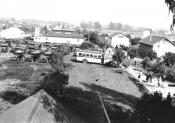
Brown's Bulb Ranch, late 1920s
Several successful Capitola industries were developed by the family of James Brown, who built a cottage along the dirt lane of Forty-First Avenue in 1911. When he planted begonias there in 1921, the ranch quickly became a worldwide producer. Seeking fertilizer for the bulbs, Brown bought 14 registered heifers and a bull, and began one of the state's finest Guernsey herds. Over the years, the tradition of the Brown family remained its diversity, from the production of Moo Cow Ice Cream and the establishment of Moo Cow Stores, to the reputation of Capitola as the "Begonia Capital of the World."
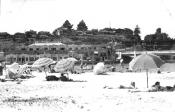
Capitola's Beach in the 1930s
Although Capitola suffered during the Great Depression, a day at the beach was still affordable for many "weekend tourists" who enjoyed the cooling fogs and sunshine along the coast.
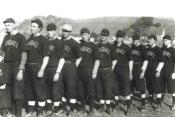
Capitola's Favorite Baseball Star, Harry Hooper
Capitola's favorite sports hero is Harry Hooper, lead-off hitter and right fielder for the 1912, 1915, 1916, and 1918 World Champion Red Sox. Harry first saw Capitola when his parents moved here in the summer of 1907. Years later, he made his home in the village, and served as postmaster from 1933 until his retirement in 1971. Hooper was inducted into the Baseball Hall of Fame on August 9, 1971. In this photograph, Hooper (in the white cap) posed with the local Soquel team.
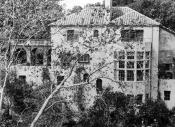
Rispin Mansion, ca. 1930
When Capitola's owner F.A.Hihn died in 1913, his daughter, Katherine Cope Henderson, put the resort up for sale. H. Allen Rispin, a wealthy San Franciscan, bought it at the end of World War I. Although he had grand plans to develop "Capitola by-the-Sea," Rispin overextended himself and was broke by 1928. He lost his elaborate 22-room mansion and most of his holdings in 1930-31. This picture was taken after the Rispin home had been sold to Burlingame millionnaire Robert Hays Smith. The Smith family ran into financial problems during The Great Depression and surrendered the mansion in 1939. It was then sold to the Catholic Church for use as a convent by the Order of Poor Clares. The nuns resided at the complex until 1957. The mansion has since been vacant of permanent residents, and is now owned by the City of Capitola.
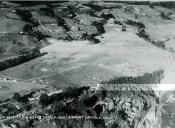
El Salto Resort, Camp McQuaide, & the Capitola Airport -1934
This photograph was taken shortly after the Santa Cruz-Capitola Airport was officially established in 1934. El Salto Resort, the private retreat of the Lewis Hanchett family, is in the foreground. The tents are part of the encampment of the 250th Coast Artillery, later known as Camp McQuaide. The Capitola Elementary and New Brighton Middle Schools now occupy the site.
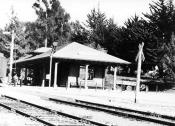
Capitola Depot, ca. 1935
The Capitola Depot was moved to its third location in 1904, facing Park Avenue and the tracks of the Southern Pacific Railroad. Service continued there until 1950. Early in the 1960s, the depot was purchased and moved to face Monterey Avenue. Extensively remodelled, it is now a bed & breakfast known as the Inn at Depot Hill.
